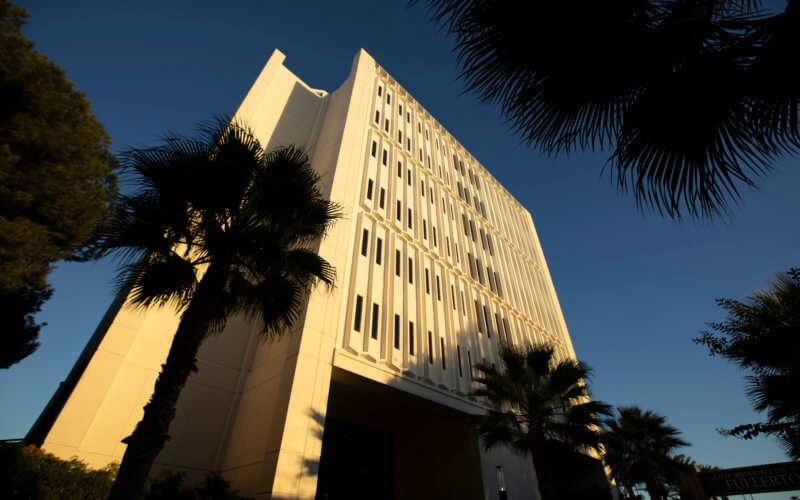
What is the fiscal state of the university? And what should the campus expect in the upcoming year?
Cal State Fullerton President Sylvia Alva, Provost and Vice President for Academic Affairs Amir Dabirian, and Vice President for Administration and Finance and CFO Alexander Porter provided an overview to the Academic Senate, describing the fiscal state of the university. While there are certainly challenges, the university’s overall financial position is sound.
Setting the Stage and Context
“Topics that are trending are the governor’s compact, enrollment, tuition increases and salary compensation,” said Alva, opening the presentation. “This is designed to be a high-level overview. My role is to provide the context and set the stage for our conversation.”
Alva explained that the governor has proposed annual, year-over-year ongoing general fund base increases of 5% from 2022-23 through the 2026-27 fiscal years. In addition, the 2022-23 governor’s budget provides a 1% increase in resident undergraduate enrollment. This is an increase of 9,434 full-time equivalent California State University students. At CSUF, the increase is closer to 1.9% based on enrollment and capacity to grow.
“This increase helps ensure all students have opportunities to earn the lifelong, life-transforming benefits of a CSU degree,” Alva said. “It addresses the decline in state funding over the decades, acknowledges limited state support in the future, helps address the funding gap and improves the financial sustainability and predictability.”
Beginning in the 2024-25 academic year, all CSU students will see a tuition increase. Undergraduate students taking six or more units will spend about $6,084 during the first academic year. By 2028-29, that amount will rise to $7,682. CSU’s tuition for all undergraduates, graduates, and credential students averages about $7,520 per year compared to the national average of $12,451, keeping CSU one of the best bargains in higher education.
In addition, 60% of CSU undergraduate students have their tuition fully covered by state waivers, Cal Grant tuition awards and state university grants.
It should also be noted, Alva added, that there has only been a single 5% increase in tuition over the past 11 years.
“We are deeply committed to providing access to our students and we will continue to try to provide support for our students, understanding that tuition isn’t their only cost,” Alva said. “We know there are expenses for parking, books, housing and more. We have a working group to find sustainable options supporting our students financially, including the adoption of digital materials and affordable learning solutions.”
There are also pending agreements over salary compensation and active negotiations with several unions on campus. These adjustments will influence the budget as well.
Fiscal Status, End of Fiscal Year 2022-23
Porter provided details on the 2022-23 fiscal year core operating funds and lottery funds broken down by divisions with the largest share going to academic affairs, as expected.
Of the core operating fund expenditures and transfers ($583.4 million), 70% was allocated to employee compensation and benefits, followed by other expenses/transfers (12%), financial aid (11%), information technology (4%), and utilities (2%). Equipment, contractual services, library acquisitions, travel and communications each account for less than 1% of these funds.
Funds must also be designated for reserves to deal with economic uncertainties, recommended reserves per CSU policy (the minimum required is three months’ worth of operating funds; recommended is six months) and operating fund budgets. Fiscal year budget 2022-23 has a total of $176,906,888 allocated under reserve designations.
Looking Ahead: Fiscal Year Status, 2023-24
The 2023-24 fiscal year’s operating fund baseline budget ($542.5 million) is based on two income sources: tuition and fee revenues (47%) and state allocation (53%). For 2023-24, the projected compensation and benefits is the largest user of these funds (72%), followed by other expenses and financial aid (each receiving 11%), information technology (3%), utilities (2%), and equipment, contractual services, library acquisitions, travel, and communication (all receiving less than 1%).
“Among our multi-year budget plan considerations are increasing costs and inflation, although it looks as if inflation is slowing down a bit,” Porter said. “We must also more closely align our budget with enrollment and effectively manage over-enrollment.”
Investing in Faculty
Dabirian focused on issues directly affecting faculty.
“This academic year, we welcomed 30 new tenure-track faculty,” he said. “We are focused on building a more diverse faculty and this year, we welcomed 10 faculty members who are Asian, eight faculty who are white, six faculty who are Black, four faculty who are Hispanic, one faculty member who is two or more races, and one who chose not to disclose.”
In 2022-23, there were 38 tenure-track faculty searches conducted with 25 eventually being hired. For 2023-24, 39 faculty searches were conducted with CSUF, and 30 were hired.
In addition, 40 faculty received tenure during 2022-23 and 61 received promotions. In 2023-24, 35 faculty members received tenure and 67 were promoted.
“I am very encouraged by the progress and promotions,” Dabirian said. “We like to see associate professors become full professors.”
In 2022-23, lecturer range elevations numbered 104. In 2023-24, 46 lecturers received a range elevation.
“I want to encourage lecturers to apply for range elevations,” Dabirian said. “We know our lecturers work very hard and we want to continue to reward them. However, if they don’t apply for a range evaluation, we can’t consider them for a promotion.”
Finally, Dabirian noted in 2022-23, 58 sabbaticals were awarded. In 2023-24, 60 were granted.
“In addition to full professors, we also want to encourage associate professors to apply for sabbaticals,” he said. “This may be helpful in helping them achieve a promotion to full professor.”
Visit the resource planning and budget page to review budget reports.